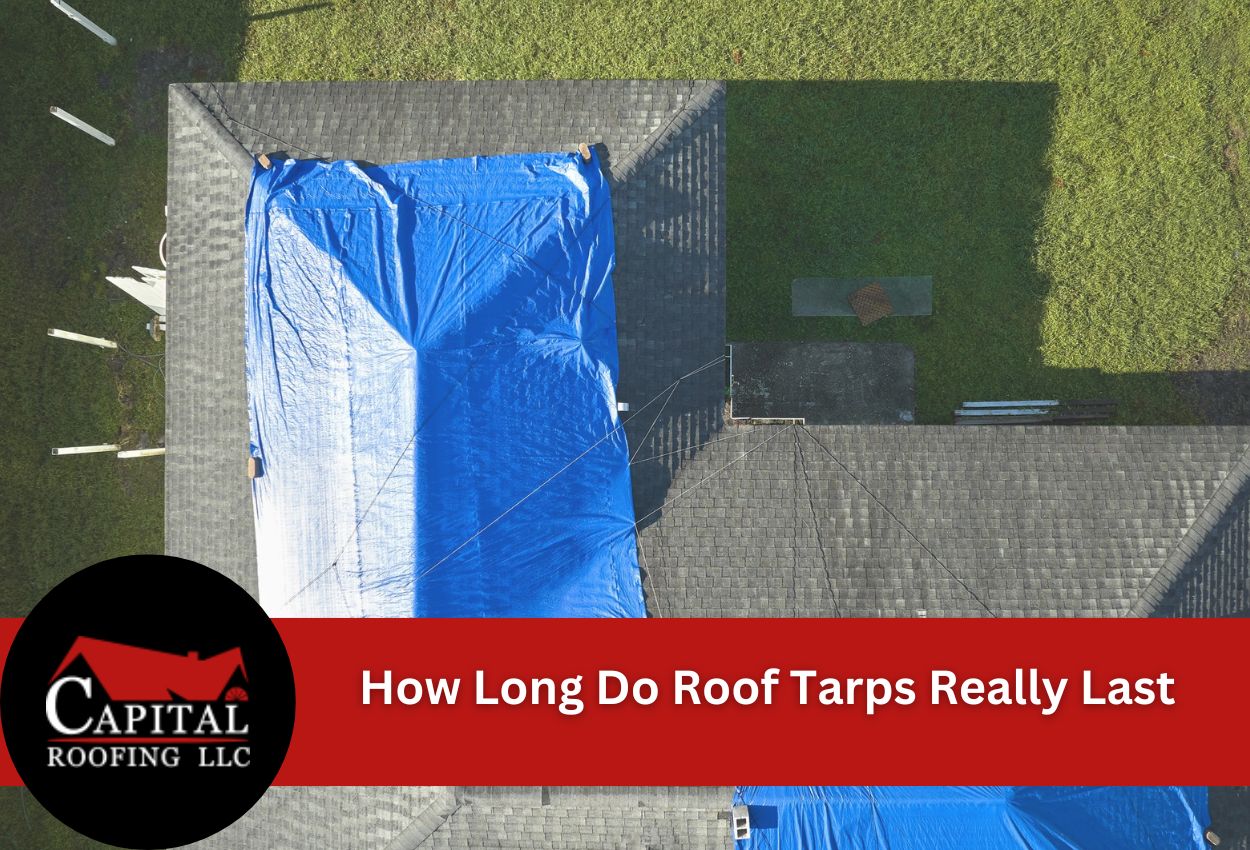Roof tarps are an important, temporary protection when storms, fallen trees, or other emergencies damage residential roofing systems. Knowing how long roof tarps last becomes essential for homeowners facing unexpected roof damage who need reliable temporary coverage while planning and waiting for permanent repairs.
The lifespan of roof tarps varies significantly based on the material quality, weather conditions, and installation methods. Standard blue poly tarps typically last 30 to 90 days under normal weather conditions, while heavy-duty vinyl or canvas options can provide protection for six months to a year when properly installed and maintained.
Weather conditions play the most significant role in determining tarp longevity. Constant sun exposure breaks down tarp materials through UV degradation, and high winds, heavy rain, and temperature fluctuations accelerate wear and tear. Areas experiencing severe weather conditions may see tarp effectiveness drop within weeks rather than months.
Installation impacts how long roof tarps remain effective. Tarps secured with appropriate fasteners and adequate overlap resist wind damage and leaks better than hastily installed coverings. Material thickness also matters, with heavier mil ratings typically offering extended protection periods.
Knowing realistic timeframes for roof tarp durability helps homeowners plan appropriate temporary protection strategies and avoid extended water damage while coordinating permanent roofing solutions.
Material Matters: Different Tarp Types and Their Expected Lifespans
The material composition of roof tarps directly determines how long they will effectively protect damaged roofing systems. Polyethylene tarps, commonly recognized as blue poly tarps, represent the most affordable option, but, as mentioned above, typically last only 30 to 90 days under average weather conditions. These lightweight materials work well for short-term emergency coverage but deteriorate quickly when exposed to constant UV radiation and temperature changes.
Heavy-duty vinyl tarps provide the longest protection timeframes, potentially lasting 6 months to 1 year, depending on weather exposure. Vinyl materials feature reinforced edges, superior UV resistance, and enhanced waterproof coatings that maintain integrity through multiple storm cycles.
Material thickness significantly impacts tarp longevity, with measurements expressed in mil ratings. Standard 6-mil tarps work for basic coverage, while 10-mil ot 20-mil options offer extended durability. Once you get to 16-mil, the tarp can begin to get harder to work with due to the added weight. Weave quality and waterproof coating applications also influence how long roof tarps last, with reinforced grommets and sealed seams preventing premature failure points that compromise overall protection effectiveness.
Weather Conditions That Shorten Your Roof Tarp’s Life
Weather represents the primary factor determining how long roof tarps last, with various environmental conditions accelerating material breakdown and reducing protective effectiveness. UV radiation from constant sun exposure causes the most significant damage to tarp materials, breaking down polymer chains and creating brittle, cracked surfaces that compromise waterproof barriers within weeks of installation.
Extreme temperatures create expansion and contraction cycles that stress tarp materials and fastening points. Summer heat makes tarps more susceptible to tearing, while freezing temperatures cause materials to become rigid and prone to cracking. Wind conditions present additional challenges, with sustained gusts loosening fasteners and creating flapping motions that weaken the material integrity over time.
Seasonal weather changes compound these effects, particularly during transition periods when temperature swings and increased precipitation test tarp durability. Heavy rain saturates materials and adds weight stress, while ice accumulation can cause catastrophic failure of temporary roofing protection.
Oklahoma’s climate presents unique challenges for roof tarp longevity due to intense summer heat, severe thunderstorms, and occasional ice storms. The state’s high UV index during summer months can reduce standard poly tarp effectiveness to just 30 days, while spring tornado season brings wind conditions that frequently compromise temporary roof protection. Homeowners in the Claremore area should expect accelerated tarp replacement schedules during peak weather seasons and consider heavy-duty materials for extended protection periods.
Installation Quality: Why Proper Setup Extends Tarp Duration
Professional roof tarp installation technique significantly impacts how long roof tarps last by ensuring secure attachment points and proper water drainage patterns. Correct anchoring involves extending the tarp at least 3 to 4 feet beyond damaged areas and securing edges with appropriate fasteners spaced every 12 to 18 inches. This prevents wind uplift and maintains consistent coverage during severe weather.
Tension management is important for increasing the lifespan of the tarp, as loose materials flap in the wind and create stress points that lead to premature tearing. Properly tensioned tarps distribute weight evenly and shed water effectively, while slack areas collect debris and moisture that accelerate material breakdown. Professional roofing contractors know what the best tension levels are that protect, without overstressing, attachment points.
Edge sealing methods determine waterproof effectiveness and prevent leaks that can cause additional structural damage. Quality installations include overlapping seams, sealed edges, and strategic placement that directs water flow away from vulnerable areas. These techniques extend protection periods and keep the tarp material’s integrity in check through multiple weather cycles.
Common installation mistakes drastically reduce tarp effectiveness and require early replacement. Inadequate fastening allows wind lifting, while insufficient overlap creates water entry points. Using the wrong fastener types damages both tarp materials and roofing substrates, leading to expanded repair needs. Poor drainage planning causes water pooling that stretches materials beyond capacity and creates failure points that compromise temporary protection systems.
Warning Signs Your Roof Tarp Needs Immediate Replacement
Recognizing when roof tarps have reached the end of their protective lifespan prevents additional water damage and maintains adequate temporary coverage until permanent repairs can be completed. Visual inspection reveals several clear indicators that signal immediate replacement needs, helping homeowners protect their property investments during extended repair timelines.
Visible tears represent the most obvious sign that the roof tarp’s effectiveness has been compromised. Even small punctures allow water to leak in, which can cause extensive interior damage, while larger rips eliminate protective coverage entirely. UV degradation appears as fading, brittleness, or chalky residue on tarp surfaces, indicating material breakdown that reduces waterproof capabilities.
Loose attachment points create flapping areas that get worse during high wind and signal fastener failure or material stretching around securing hardware. Sagging sections indicate water pooling or structural inadequacy that prevents proper drainage and adds excessive weight stress to remaining secure areas.
Performance issues provide additional replacement indicators beyond visual deterioration signs. Water leaks appearing in previously protected areas demonstrate compromised waterproofing that requires immediate attention. Persistent flapping sounds during normal wind conditions suggest inadequate tension or attachment failure that will only get worse without intervention.
Edge separation from securing points, discoloration indicating mold or algae growth, and stretched material around fastener locations all signal that temporary roof protection systems have exceeded their effective lifespan and need a quick replacement to maintain adequate coverage.
Extending Your Roof Tarp’s Protective Life Through Proper Maintenance
Regular maintenance practices can significantly extend how long roof tarps last while maintaining their effectiveness against bad weather. Simple inspection routines performed monthly help identify potential problems before they compromise the entire temporary roofing system. These proactive measures often double the expected lifespan of quality roof tarp installations.
Debris removal represents the most important maintenance task homeowners can perform to preserve roof tarp durability. Leaves, branches, and other accumulated materials create weight stress and trap moisture against tarp surfaces, accelerating material breakdown. Weekly clearing during the fall and after storms prevents punctures and maintains proper drainage patterns that extend the temporary roof protection’s effectiveness.
Checking fastener security prevents the gradual loosening that occurs through normal wind exposure and temperature cycling. Tightening loose screws or replacing failed fasteners before they create larger problems maintains consistent coverage and prevents progressive failure of the entire installation. Examining the integrity of edge sealing ensures waterproof barriers remain intact.
Minor repairs, such as patching small holes or reinforcing stress points, can extend the roof tarp’s lifespan by several weeks or months. Tarp repair tape designed for outdoor applications provides temporary fixes for punctures smaller than 2 inches, while larger storm damage typically requires complete replacement. Regular upkeep directly impacts weathering resistance by addressing deterioration before it spreads throughout the entire protective covering system, helping homeowners maximize their investment in emergency roof covering materials.
Planning Your Permanent Roof Repair Timeline Around Tarp Lifespan
Understanding roof tarp lifespan provides the foundation for developing realistic, permanent repair schedules that maintain continuous protection throughout the restoration process. Property owners must coordinate temporary roof protection replacement cycles with contractor availability and material procurement timelines to prevent gaps in coverage that could result in additional structural damage.
Standard roof tarp durability expectations should drive permanent repair planning from the initial damage assessment. Heavy-duty tarps lasting 6 months to 1 year provide flexibility for complex repairs requiring extended timelines, while standard poly tarps’ shorter lifespans need accelerated permanent solutions. These timeframes establish realistic windows for completing insurance processes, obtaining permits, and scheduling professional roofing contractors.
Roofing professionals can coordinate tarp replacement schedules with permanent repair phases to ensure seamless protection transitions. Strategic planning involves evaluating current tarp condition against remaining project timeline requirements, ordering replacement materials before failure occurs, and scheduling installation during the best possible weather conditions.
Seasonal considerations significantly impact both temporary roof protection longevity and permanent repair scheduling. Spring and summer months offer ideal conditions for roofing projects, but also accelerate tarp deterioration through UV exposure and storm activity. Fall installations may extend tarp effectiveness but reduce available working days for permanent solutions before winter weather arrives. Successful timeline coordination requires balancing these competing factors while maintaining adequate protection throughout the entire repair process until permanent roofing systems restore complete structural integrity.
Get Continuous Protection with Capital Roofing
Understanding how long roof tarps last is important for maintaining the integrity of your home’s roof, especially in the face of unexpected damage. At Capital Roofing, we specialize in providing top-quality roof tarps that are designed to offer durable, temporary protection until permanent repairs can be made. Our tarps are tailored to withstand Oklahoma’s unique climate conditions, ensuring your home stays safe and dry.
Call us today at (918) 260-4075 to discuss your options with one of our experienced professionals. We’re here to help you effectively manage your temporary roof protection and plan for a seamless transition to permanent repairs.

